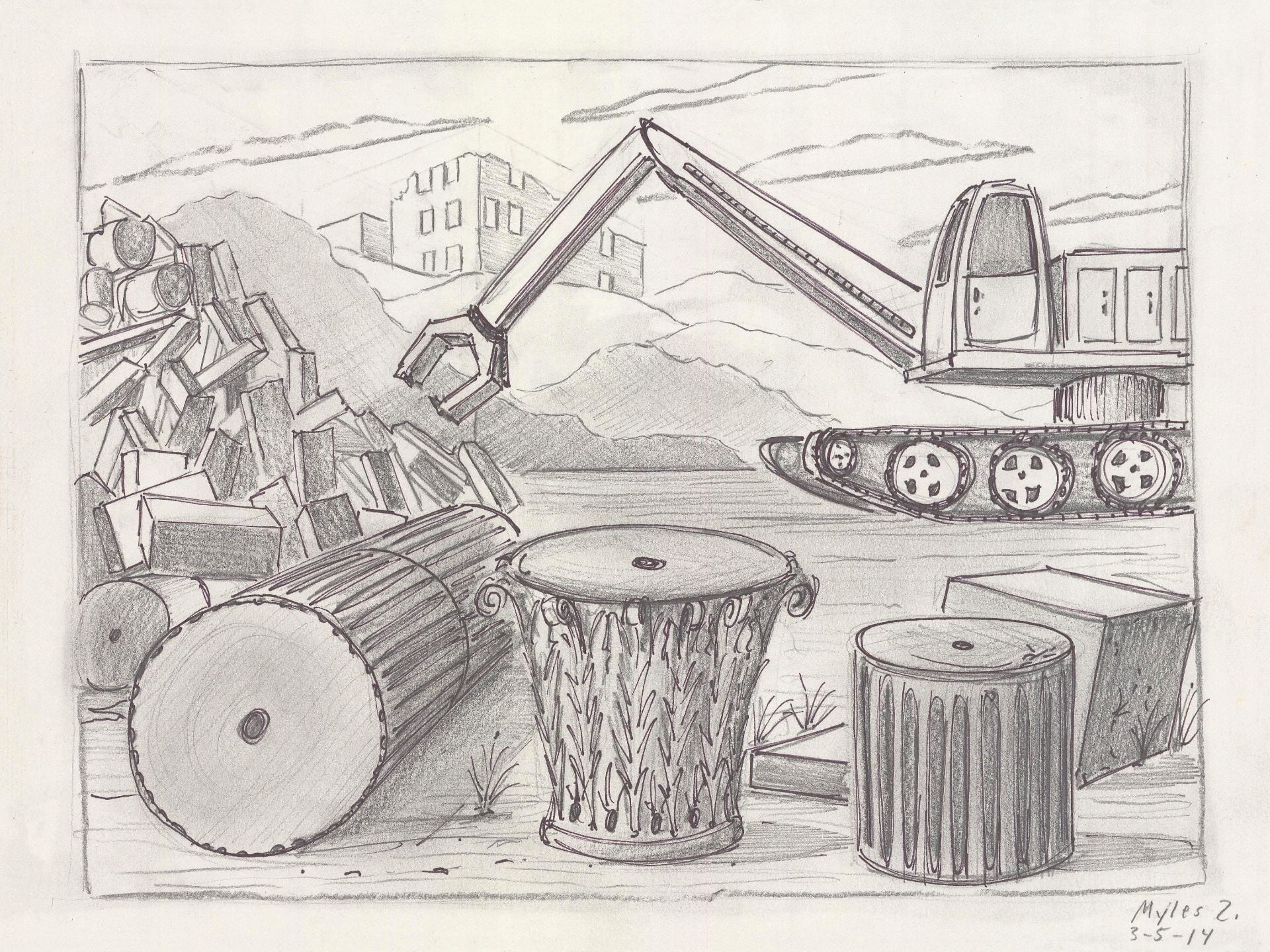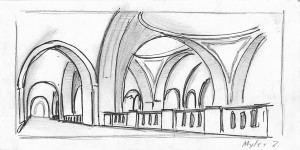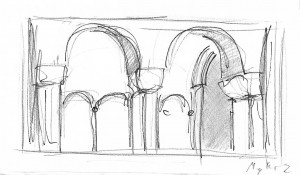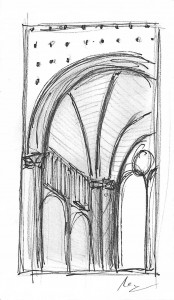Rome left a footprint on the built environment.
What will our society leave?
Essay selected from successful 2014 application to the Telluride Association Summer Program
.

.
Visitors to the ruins of vanished Greece, Carthage, and Rome do not see whole structures, so much as shards of memory and the detritus of a lost civilization. Ruins’ emotive power comes less from seeing them intact and more from imagining them as they once were. There is something powerful about “the lost cause.” The imagery of loss draws viewers in to imagine a civilization that was or still could be if history had gone differently. Roman culture and art left a visible impact on the built environment, and on how later civilizations constructed their own identities through claiming legitimacy (real or imagined) descended from Rome. The aesthetics of the southern plantation house, the US state capitals, and thousands of old bank buildings evoke the imagery of Roman columns, white marble, and solid proportions. What material legacy will our own civilization leave when it, too, splinters apart? Who or what is included in the process of memory making? Who is left out?
There are many ways to answer this question. One way is to compare the principles of ancient architecture with the realities of modern culture, and to see where they diverge. This divide is well illustrated by one book: De Architectura or The Ten Books on Architecture, written around 30-15 BCE by Vitruvius, a Roman architect and engineer. From the Renaissance to the Industrial Revolution, architects drew on the content of this book as a user manual and their profession’s “Bible.” Vitruvian design principles guided Palladio for his Venetian villas, Brunelleschi for his Florentine dome, and da Vinci for his drawing of Vitruvian Man. In the face of centuries of tradition, modern architecture diverges from Vitruvius’ aesthetic standards. The globalized world of today with its shimmering skyscrapers, speeding trains, and growing reliance on the Frankenstein of technology makes Roman technological achievements seem small and quaint by contrast. Rome and Vitruvius were steeped in the ornament of tradition and precedent that modern architecture dispenses with. Roman culture seems to have little do with, or say about, modern culture and architecture.
Read More
.

Frontispiece of “De Architectura”

Vitruvian Man (1490)
.
In De Architectura, Vitruvius identifies the three principles of good architecture: beauty (venustas), quality (firmitas), utility (utilitas). The built environment must fulfill all three; to pass the test of time is the measure of good design. I will establish the relevance of each of these principles to modern design thought.
.
Beauty—Venustas
Aesthetic principles guided the architecture of Vitruvius’s time. Vitruvius emphasizes how architecture must relate to the human body, “In the human body there is a kind of symmetrical harmony between forearm, foot, palm, finger, and other small parts; and so it is with perfect buildings” (Vitruvius 14). Vitruvius desires a continuum where well-proportioned and symmetrical humans inhabited equally well-proportioned structures. As the human body attains perfection through harmony, so too must architecture. Consequently, the architect becomes an interpreter, translating the proportions and elegance of the body into the forms of perfect buildings. As the human body has legs, torso, and head, architecture must have base, middle, and top. As the human body is symmetrical from left to right, architecture must be symmetrical from left to right. As the human body measures each organ in relation to the greater being, architecture must consider each detail in relation to the greater building. Vitruvius emphasizes continuity between man and his world, a place where man has an environment befitting his stature. The gendered language is Vitruvius’, not mine.
Yet behind this devotion to replicating human forms in architecture, there are the seeds of racial prejudice. “In fact”, writes Vitruvius, “the races of Italy are the most perfectly constituted in both respects — in bodily form and in mental activity to correspond to their valour” (173). There seems to be the following implication: If humans are perfect creations in the image of the gods, then a perfect building should draw from the perfect human. Furthermore, since Roman people are the finest people in the world, Roman architecture must be the finest architecture in the world. The creation myth that Roman people are descended from the gods via Romulus and Remus, as well as the sophisticated appearance of the Roman built environment, is used to justify conquest and colonialism. Vitruvius sees aesthetics as a linear evolution where Roman architecture and Roman culture are the specious pinnacles of progress. In comparison, the narrative of the Industrial Revolution and capitalism’s claim to technological progress seems to claim, like Vitruvius, that our own civilization is the most advanced and best. It is the end of history.
Modern architecture, unlike Roman architecture, does not obey Vitruvian principles of construction and aesthetics. Like Vitruvius in service of his client, the Roman Empire, modern architects can also be agents of injustice through their design of prisons and institutions that perpetuate violence. Unlike Roman structures, the modern built environment has turned toward functionalism, rationalism, and cost-saving measures at the expense of hand carved stone ornament. All of Vitruvius structures were designed by and for people to live and work in. Today sees whole new varieties of structures for different types of “people” – houses for cars, houses for airplanes, houses for industrial equipment, electricity generators, and computers. The superhighway and skyscraper of today dwarf the Roman roads and crumbling obelisks of antiquity. Building materials have changed from stone, earth, and wood to sheetrock, fiberglass, and plastic. The constraints of economy dictate that modern structures need not model the human form. The built environment has become alienating.
.

Learning from Las Vegas

Learning from Las Vegas
.
On the one hand, the erosion of human aesthetic standards and the wide array of new building materials gives the architect greater autonomy. On the other hand, this same absence permits clutter and disorder. Learning from Las Vegas, a 1972 essay by architect Robert Venturi reads the respective urban plans of Rome and Las Vegas as symbols for different philosophies of space. Rome, a classical city created over millenia, is built of stone in obedience to Vitruvius’ principles. Most Roman structures have a well-defined base, middle, and top (usually the terracotta roof) and are of similar symmetry, height, style, and scale. Most structures also relate to their urban environment through their human-scale density and orientation to the sun. The scale is human; the city is a microcosm. By metallic contrast, Las Vegas, an asphalt civilization constructed in the desert, is fabricated of all materials with little planning or care for beauty. The presence of a foe brick and stone casino clashes with the glass and metal of a next-door skyscraper. The Moroccan style theater clashes with the Federalist style motel, which clashes with the postmodern fairytale castle. Las Vegas is not alone; rather, its chaos and clutter are exaggerations of Main Street and the roadside America of strip malls, car washes, and prefabricated houses. With technology comes freedom of movement and aesthetics but also an associated disorder and non-Vitruvian decadence.
One should ask if it is possible to continue practicing the aesthetic of Vitruvius in contemporary society. Probably not. To start, the scale of architecture and its role in society is different. Monolithic architecture was key to solidifying the legitimacy of Roman rulers and the breadth of Roman conquests. Architecture seemingly does not play a comparable role in twenty-first-century society, where politicians quibble over funding for infrastructure and the arts. The profession of architect is also different. In Vitruvius’ time, the architect was also an engineer who oversaw even the smallest technical detail; for example, Vitruvius devotes much of his book to describing engineering methods to be employed by architects. In our time, the architect is no longer an engineer because the technical complexity of a modern building like an airport or hospital is far beyond the design abilities of any single person. Whereas Vitruvius’ time saw the concentration of talent and power in the hands of the master architect, our time sees the dispersal of talent and power in the hands of engineers, electricians, plumbers, lawyers, architects, and the rest who collaborate on construction. In this manner, the construction methods (and materials) underlying Roman architecture are inapplicable to contemporary society. While Vitruvius expected three rustic qualities of architecture – quality, utility, and beauty – occupants today expect a lot more: electricity, gas, plumbing, heating, wifi, etc.
Society should shape its architecture according to its needs, not the reverse. Architecture, even if the aesthetic ideal is as refined as Rome’s, should not confine society to the trappings of history and style. As urban historian Kenneth T. Jackson writes: “History is for losers. Preservation is used as a political tool rather than a tool to preserve buildings.” We cannot and should not unquestioningly emulate Rome because the cultural forces shaping our respective societies are uniquely different.
.

.
Quality—Firmitas and Utility—Utilitas
Although Vitruvian aesthetics are potentially outdated, his principles of quality and utility are not. Quality and utility transcend culture and time and are just as applicable to our society as they were to Rome’s.
Vitruvius believes the architect is responsible for building enduring structures. He writes: “Stone, flint, rubble burnt or unburnt brick, — use them as you find them […] so that out of them a faultless wall may be built to last forever” (53). Vitruvius believes that any structure, no matter how humble, must be built to last. In this manner, there is continuity, from the humblest wall to the grandest temple; all are to endure the test of time. Furthermore, it is the architect’s duty to factor both beauty and time into construction, so that a wall will be just as durable in ten years as it will be in a hundred. This mindset reveals a fixed understanding of beauty; what is valued for beauty today will remain so tomorrow. A faultless wall will remain a faultless wall; a beautiful temple will remain a beautiful temple. A building is thus an investment in quality and taste.
Roman construction methods were based on precedence and tradition. In describing the responsibilities of an architect, Vitruvius writes: “An architect ought to be an educated man so as to leave a more lasting remembrance in his treatises” (6). An architect is responsible for creating a legacy through his proud buildings and lasting treatises, much like De Architectura did for Vitruvius. The treatise serves to maintain a continuum, whereby future architects can learn from their forefathers. The building serves to commemorate one’s era and its leaders for time immemorial. Thus, there is continuity where each generation of architects contributes to following generations and refines the built environment through incremental change.
Although Vitruvius and modern architects seem to share little in common, they both agree that “form follows function” (a phrase coined by Chicago architect Louis Sullivan). Vitruvius writes that each building must be constructed in a manner that reflects how it is to be used and where it is to be situated. He goes to immense lengths describing the building materials and methods best suited to each environment. This concern with function mirrors the founding principles of modern architecture. The fathers of modern architecture, like Vitruvius, believed that a noble architecture is the pure expression of function, verticality for the skyscraper, openness for the train shed, airiness for the cathedral, and efficiency for the factory. For them, each building should have an aesthetic form that parallels and expresses its function. Ironically, modern architecture has the same founding principle as ancient architecture, even if they seem to differ in their materials and construction methods. As postmodern architect Robert Venturi writes: “We look backward at history and tradition to go forward” (Venturi et al. 3).
.
 .
.
Cause for concern?
Roman roads lasted millennia and Roman sewers are still in use; will our crumbling infrastructure last as long? Roman towers of stone withstood the elements for centuries; will our rusting skyscrapers of steel last as long? The Roman forum became legendary; this architectural space become a powerful symbol for democracy and government long after the Roman buildings themselves had decayed. Could the same destiny await our “forums” of today, the strip mall, the grocery chain, and the drive-thru? The Renaissance aspired to the grandeur of Rome; what society will aspire to the grandeur of our society? Or, will there even be much to aspire to with the twisted piles of fallen metal and the troubled environment our children will inherit?
.

Roman highway (Via Appia)

Today’s highway

Roman villa

Today’s villa

Roman obelisk – the towers of yesterday.

High voltage transmission lines – the towers of today?
.
In the end, who am I to judge? The broken statues, pottery, and amphora displayed in our museums were not made with us in mind, nor would they be valued by Romans in the shattered state the public now sees them in. The sources of much of our knowledge about Rome stem not from official texts but from the vulgar graffiti scrawled on the walls of Pompeii and the tall tales of the Satyricon, Rome’s equivalent of modern pulp fiction. If anything, this unintentional legacy humanizes past civilizations better than the often pompous monuments the Romans left behind. These accidental histories, like broken pottery and Roman garbage, reveal the lives of common people as they saw Rome. Rome left a legacy, although not always in the places and manner it intended to leave one. Perhaps we, too, may leave a legacy, although neither through our desire nor our intent. The detritus of modernity may (or may not) be valued centuries from now, if it survives. Twisted piles of rubble and plastic tupperware may (or may not) intrigue future archaeologists as they ask: How did this once prosperous and powerful civilization meet its end? Commemoration or oblivion, a future fountain of inspiration or a lasting cause of sorrow, what will become of our globalized world? Only time will tell.
.

.


